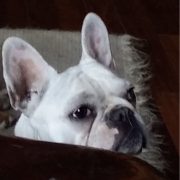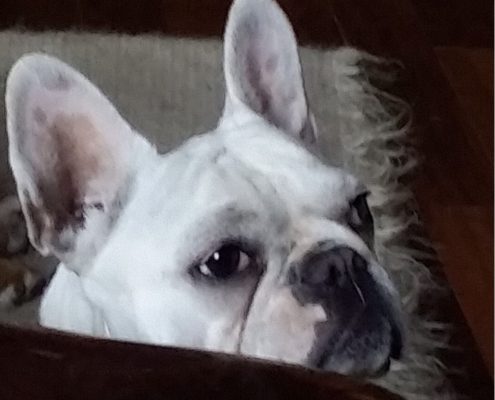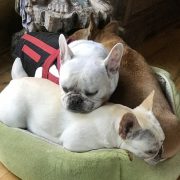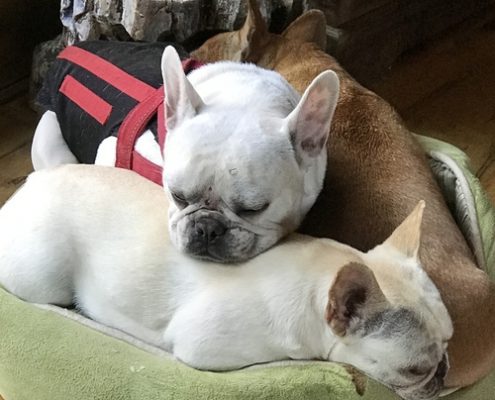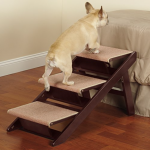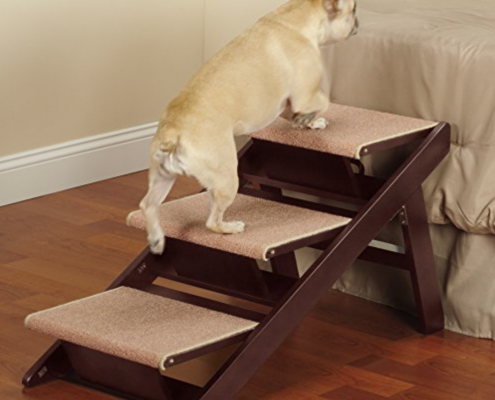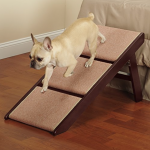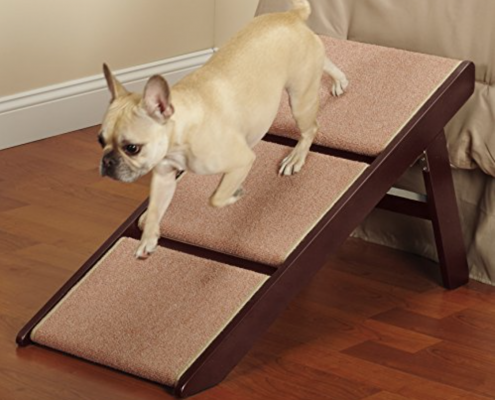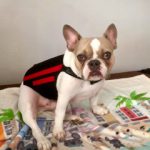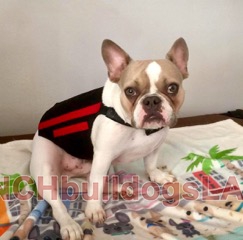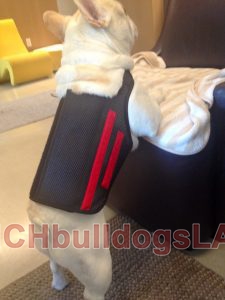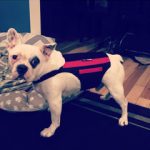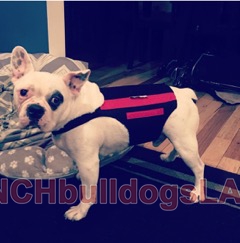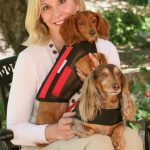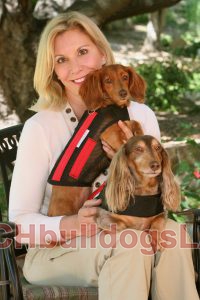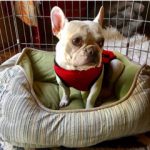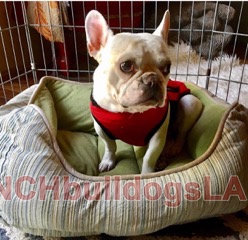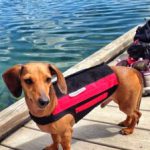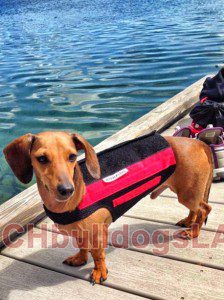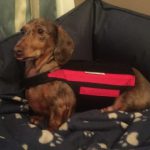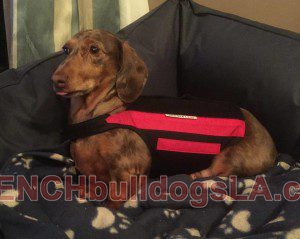IVDD in French Bulldogs: A Comprehensive Guide to Caring for Your Frenchie Puppies
My own dog was confined for weeks and suffered. This could have been prevented!
Navigating the World of IVDD
Dachshunds to French Bulldogs
From Canada to Scotland or France to Australia, pet parents everywhere may end up navigating the complex world of IVDD at some point in their pup’s life. The French Bulldog is one of the top 10 most popular dog breeds because they are amusing, affectionate, intelligent dogs but their adorable, stout appearance, is also a red flag for potential back pain.
IVDD, or Intervertebral Disc Disease, is a degenerative disease that affects countless breeds at various ages and activity levels. It occurs when discs in the spinal column begin to shift so much so that they protrude outward, pressing against the spinal cord and its nerves. The discs are thick plates—or disc-like cushions, which lie between the bony vertebrae in the spine. They are composed of a fibrous outer layer called the annulus fibrosus and a pulpy, gelatinous center called the nucleus pulposus. They help to cushion the spine as your dog walks, trots, runs, twists, or decides to do the “zoomies” or the Frenchie 500!
As time goes by, the discs start to degenerate as the blood supply to the disc decreases, making the tissues not as vital and resilient as they once were.
The soft, gelatinous central material is replaced with harder cartilaginous material, which is more easily ruptured.
Type I can affect dogs at any age, and is mostly seen in (but not limited to) chrondrodystrophic dogs, or dogs bred to be shorter and stockier. (Examples of chondrodystrophic breeds are the French Bulldog, Dachshund, Pekinese, Lhasa Apso, Shih Tzu, Basset, Beagle, and Poodle.) This type occurs when a dog’s spine experiences a sudden impact that causes the disc to shift out of place.
Type II is more gradual but the results are the same: pressure on the spinal cord and its nerves caused by a bulging disc. Type II IVDD affects older dogs between the ages of 8 and 15 by its very nature, and isn’t targeted to primarily chrondrodystrophic breeds. In the Type II disc disease, the tear in the outer layer is smaller and tends to occur gradually over a period of time. The central material tends to bulge up into the spinal canal but then falls back into place between the vertebrae. This second Type tends to occur in breeds with normal cartilage.
No matter what age they are when diagnosed, for both types of IVDD, rest, laser light therapy, anti-inflammatories, and even surgery are the common protocol and can aid in helping to manage, if not completely relieve, dog back pain. However, older dogs suffering from Type I are less likely to rebound as quickly as younger dogs and are more likely to experience continual back problems throughout their lives.
When my dachshunds Henry and his younger sister June were both diagnosed, I didn’t quite understand how she and Henry could have the exact same diagnosis—June was much younger and far more active. When June started showing symptoms, I rushed her to the ER where the vet administered Rimadyl for inflammation, Tramadol for back pain, and Roboxin to relax muscles. She was also put on confined rest for a month! I soon started researching more about the “chondrodystrophic” breed, which means a dog with short legs and long spines — learning quickly that these short-legged fluffs of love are prone to IVDD. When the vet told me that June’s back was like a “ticking time bomb” and suggested spinal surgery or maybe even euthanasia, I panicked! Henry also being diagnosed with the same thing made me examine the disease more closely and soon after, dedicate my time and energy to helping other dogs and owners alike.
Once I started my journey into the universe of IVDD, I started learning more about other breeds and met countless other dogs suffering from this dreaded disease. I had no idea dog back problems were so prevalent in dogs! French Bulldogs were at the top of the list due to their genetic predisposition towards back problems and as a dwarf breed, French bulldogs’ discs are more vulnerable than other breeds due to age-related degeneration.
Frenchies are small but solidly built, with a muscular physique, so one might think their backs would be super strong but it is quite the opposite, as being low to the ground means when they make impact, from jumping off the couch or running up and down the stairs, they come in with a hard landing!
The French Bulldog also has an odd way of sitting with his hind legs spread out — thus the nickname “frog dog.”
Although this cute stance doesn’t necessarily signal future back pain, posture is something to consider, since French bulldogs are predisposed to IVDD and Hemivertebrae (bones of the spine that are abnormally shaped).
Dogs need to be active, so I had to find a way to keep my Dachshunds from wiggling so much! Frenchies enjoy lounging around, but they are a bit like Dachshunds. Although they are low to the ground, they want to live a fun life! The most important goal for my pups became recovering them to a happy, pain free life, so they could bounce around again. The journey was long with my first two dachshunds. Thankfully understanding the world of IVDD, and managing the pain our pups can sometimes feel, is becoming easier to do as we learn more and more about the disease and the many preventative and supportive measures we can take as pet parents. We are also sharing more stories of how we can make strides towards wellness and bring relief to our fur babies.
Our lives changed forever when June and Henry were diagnosed with IVDD and a big part of my life revolved around finding ways to make their pain go away. Emergency room visits, strong medication and complete crate rest were not what I’d envisioned when we brought our sweet puppies home. Caring for a dog with IVDD can be draining emotionally, as well as financially. It was disheartening for me to watch my pups not be able to play and jump around like ‘normal’ dogs, hear them whimper in pain, and watch them have muscle spasms. No pet parent wants to see their pups not feeling well, especially when they are in physical pain.
French bulldogs might not bark much, but they do like to talk, so it is important to pay special attention if you notice any of the following signs, as they can be early warnings signals of a bigger issue, and you may need your Vet’s immediate input.
There is so much helpful advice these days on the web to help you and your little angles live a high quality life with IVDD— the key words being HIGH QUALITY LIFE!
Here are a few tips I found especially helpful during recovery:
Diet—maintain your dog’s healthiest weight to reduce stress on their backbone and neck. Making sure they have the proper nutrients and supplements is paramount during the healing process and your Veterinary can offer guidance if you are unsure what your dog’s optimum weight level should be.
Food—moisten kibble or feed them wet food. Chewing can cause stress on the jaw and neck, which can result in pain. Same goes for chew toys or treats. Abstain from these during the recovery period.
Eliminate stress on back and neck—raise food and water bowls so that your dog doesn’t have to bend down to eat or drink; keep the crate your pup is recovering in at a higher level so that he doesn’t have to raise his head to look at you or his surroundings. There are some great products on the market which allow your dog’s to comfortably retrieve their food with minimal effort.
Acupuncture Therapy—this is particularly good for dogs that respond poorly to or cannot tolerate medication. Surgery may not be an option due to health or finances. Acupuncture may be one option to look into, as it regenerates neurons mobilizing stem cell regrowth.
Laser Light Therapy—although costly, LT has been proven to reduce tenderness, pain and speed up the tissue healing process. Be sure to research this method and talk to your Veterinary before considering this as an option.
Back support—after a period of recovery, it is important to keep your dog’s back stable and straight. Wearing a back brace such as WiggleLess® puts less pressure on your dog’s spine and may help him or her to have a more enjoyable and normal life.
Environment—lots of love, comfort, warmth, encouragement, and a peaceful environment. Soft bedding, ramps, extra cushions and support will make your dog less likely to be in a position of distress. Dogs get stressed out just like us humans do. Stress makes it hard to heal!
Treatment options range from rest and conventional medicine to surgical procedures. The protocol will vary depending upon the severity of the disease and Corticosteroids or Non-steroidal anti-inflammatory medications, muscle relaxants or other drugs may be prescribed to alleviate inflammation. If medical management does not control the dog’s pain and symptoms, surgery may be recommended. Once a dog’s pain is stabilized, cage confinement for up to 6 weeks is essential to a dog’s successful recovery! Dogs may act as if their pain has subsided once the medication takes effect; however, the medication is only masking their symptoms and if allowed to roam prematurely, more damage could be done.
Despite the desire to cuddle our fur babies, owners need to be consistent in confining their dogs for the full period recommended by their veterinarian. Dogs recovering from IVDD should be on well-padded beds, and those unable to move should be turned every few hours to prevent development of sores.
Prescription pain and anti-inflammatory medications will be reduced gradually over time and dogs with IVDD should do minimal exercise while recovering. ‘On-leash’ walks and using a harness instead of a neck collar will help, while physical therapy, such as swimming or other water exercise, allows comfortable mobility when working key muscles. Other techniques to aid healing, such as massage therapy, may help to reduce overall pain and stress. Acupuncture or acupressure techniques and use of herbal or other supplements can also alleviate pain. The goal with any healing practice is to increase circulation, ease pain, speed healing and promote wellness, while keeping your loved one calm.
Many dogs with Intervertebral Disc Disease do very well without surgery, especially if their disease is caught and treated early and owners are consistent about strict cage confinement during the entire recovery period. Your veterinarian will determine the best medical protocol for IVDD and your dog. If your dog is in severe back pain due to IVDD, one or more of the following medications may be prescribed:
Steroids: They are anti-inflammatories and immune system suppressors. They are good especially if given in the vein the first 8 hours or by shot in the muscle, and followed by pills at home. The most commonly used are: prednisone and dexamethasone. Accompany with a stomach protector such as Pepcid (famotidine).
NSAIDs (non steroidal anti-inflammatory drugs): they are anti-inflammatories, and also have pain killing properties too. They must never be mixed with steroids or the NSAID aspirin. The most commonly used are: Rimadyl, Deramaxx, Previcox or Metacam. Accompany with a stomach protector such as Pepcid (famotidine).
Muscle Relaxers: During a herniation a dog can have nasty muscle spasms. Muscle relaxers help prevent them and they also help keep the dog calm while in crate rest. The most commonly used are: Methocarbamol and Valium.
Pain Killers or Analgesics: They help through the healing period by making your dog more comfortable. The most commonly used are: Tramadol or a Fentanyl patch.
Remember that all drugs have side effects and some (steroids and NSAIDs) need to be given with a stomach protector. Steroids and NSAIDs should never be mixed or switched without washing out the other from the body for 7 days. Ask your vet or pharmacist for an informative brochure on each drug or search the web for adverse side effects.With the right diagnosis and the right treatment, IVDD is manageable, and making your dog feel loved and happy is top of the list! At WiggleLess®, we strive weekly to work with the local community and our friends across the US and abroad to bring IVDD to the forefront of the pet community so we can all learn and share but most of all help all our beloved dogs to live the longest, healthiest lives possible.
AUTHOR BIO: Lisa Luckenbach has developed WiggleLess® back braces for dogs that are overweight and need extra support, elderly with aching backs, diagnosed with IVDD-related back problems, or overly active and can benefit from the structure a dog back brace provides. In addition to running WiggleLess®, Lisa is a registered yoga instructor, licensed massage therapist, public speaker, ordained minister, and breast cancer survivor. She shares her home with her husband and three spunky, adopted dogs, Ryder (Cocker Spaniel), LaVerne (Schnauzer/Doxie mix), and Chai (Doxie/Beagle mix). Visit WiggleLess®.com to learn more about Lisa and her back brace for dogs.
